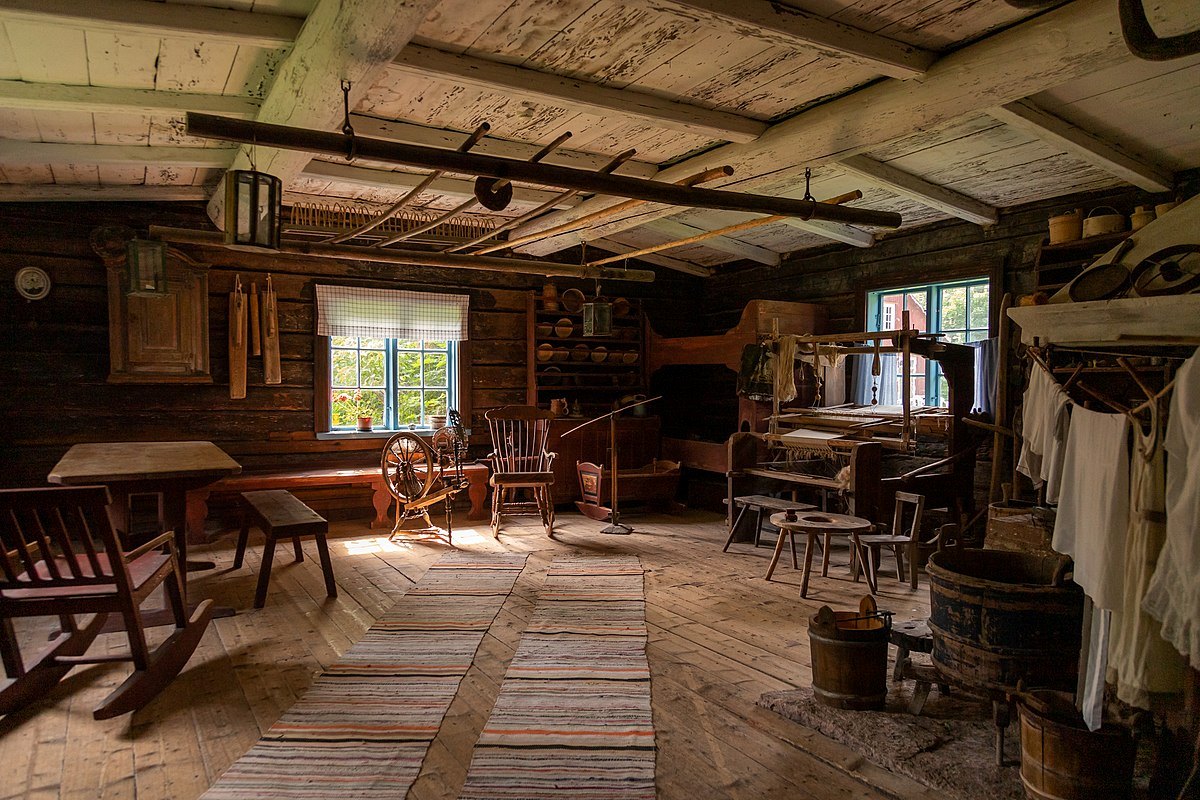

Articles
Who Invented The Fire Escape Ladder
Modified: February 22, 2024
Discover the history of fire escape ladders and the visionary inventors behind them in this insightful article. Gain knowledge and appreciation for these life-saving devices.
(Many of the links in this article redirect to a specific reviewed product. Your purchase of these products through affiliate links helps to generate commission for Storables.com, at no extra cost. Learn more)
Introduction
A fire is a devastating and destructive force that can quickly turn into a life-threatening situation. In the event of a fire, having a safe and reliable means of escape is of paramount importance. One such means of escape is the fire escape ladder, a device designed to provide a quick and efficient exit from a building during a fire emergency. But who exactly invented the fire escape ladder?
In this article, we will explore the early history of fire escape ladders and the individuals who played a pivotal role in their development. We will delve into the contributions of Anna Connelly, a pioneering woman in the field, and the significant advancements made by Joseph Winters. We will also highlight the improvements and innovations that have been made to fire escape ladders over the years, as well as provide an overview of contemporary fire escape ladder designs.
By understanding the origins and evolution of fire escape ladders, we can appreciate the importance of this life-saving invention and the impact it has had on building safety.
Key Takeaways:
- Anna Connelly’s innovative fire escape ladder, patented in 1887, revolutionized building safety and set a precedent for future advancements. Her collapsible, counterbalanced design provided a practical and efficient means of escape during fire emergencies.
- Joseph Winters’ versatile fire escape ladder, patented in 1878, not only improved safety but also accommodated individuals with limited mobility. His folding design and focus on accessibility paved the way for modern fire escape ladder innovations.
Read more: How To Use Fire Escape Ladder
Early History of Fire Escape Ladders
The concept of a fire escape ladder can be traced back to ancient civilizations, where various methods were employed to aid in evacuating buildings during fires. In ancient Rome, for example, ropes were used to descend from upper floors to the ground.
However, it was during the late 18th and early 19th centuries that the development of fire escape ladders began to take shape. In the early 1800s, as urbanization and industrialization led to the construction of taller buildings, the need for reliable means of escape in case of fire became increasingly pressing.
One of the earliest recorded instances of a fire escape ladder was in 1784, when Daniel Maseres, an English lawyer and mathematician, patented an invention called the “fire escape machine.” It consisted of a platform attached to long ropes or chains, which could be lowered from a window to the ground. While Maseres’ invention was a significant step forward, it lacked widespread adoption and remained largely experimental.
In the early 1840s, a crucial breakthrough in fire escape ladder design came from the United States. Recognizing the need for a practical and efficient solution, American inventors began experimenting with different designs.
One notable inventor during this period was Abraham Wivell. In 1845, he patented an iron ladder that could be attached to the window frame, allowing people to safely descend from upper floors. While Wivell’s design was a significant improvement, it was still limited by its reliance on strong window frames for support.
It was not until the mid-19th century that a more widespread and reliable solution emerged with the introduction of external fire escape ladders. These ladders, made of iron or steel, were attached to the exterior walls of buildings, providing a means of escape that was independent of the building’s structure.
Overall, the early history of fire escape ladders is characterized by experimentation and gradual improvements in design. These early inventors laid the foundation for the life-saving devices we rely on today during fire emergencies.
Contributions of Anna Connelly
One significant figure in the development of fire escape ladders is Anna Connelly, who made notable contributions to building safety during the late 19th century.
Anna Connelly was an Irish immigrant living in New York City in the 1870s. Recognizing the growing need for effective fire escape solutions in urban areas, she became determined to find a solution that would provide a safe means of escape for residents of multi-story buildings.
In 1887, Anna Connelly patented her innovative fire escape ladder. Her design consisted of an exterior metal ladder that could be lowered from the upper floors of a building to the ground. It was collapsible for easy storage and featured a counterbalance system, allowing individuals to descend safely and easily.
This invention was groundbreaking for its time. It addressed many of the limitations and challenges faced by previous fire escape ladder designs. Connelly’s ladder offered a practical and efficient solution that could be easily installed on the exterior of buildings, providing a reliable means of escape in case of fire.
Anna Connelly’s contributions did not stop at her patented ladder design. She was also deeply invested in promoting fire safety and educating the public. She worked tirelessly to raise awareness about the importance of fire prevention, evacuation plans, and the proper use of fire escape ladders.
Anna Connelly’s fire escape ladder gained significant recognition and was widely adopted in New York City and other cities across the United States. Her invention saved countless lives and set a precedent for future innovations in building safety.
Today, Anna Connelly’s contributions to fire escape ladder design and fire safety are remembered as pioneering achievements. Her innovative thinking and dedication to saving lives continue to influence and inspire advancements in building safety technology.
The Role of Joseph Winters
In the late 19th century, another important figure emerged in the development of fire escape ladders – Joseph Winters. Winters, an African American inventor and entrepreneur, made significant contributions to the improvement and innovation of fire escape ladder designs.
Born in New Jersey in 1816, Joseph Winters was a highly skilled blacksmith with a passion for engineering. In 1878, he patented his most notable invention – an improved fire escape ladder design.
Winters’ fire escape ladder featured a folding design, allowing it to be easily stored and deployed when needed. The ladder was made of durable metal and had additional safety features such as anti-slip rungs and stabilizing hooks for secure attachment to windowsills or balconies.
What set Joseph Winters’ fire escape ladder apart was its versatility. Unlike previous designs that were limited to being deployed from windows, Winters’ ladder could be used both inside and outside of a building. This allowed for greater flexibility in evacuation strategies and made it easier for people to reach safety from multiple locations within a building.
Furthermore, Winters’ ladder was specifically designed to accommodate the needs of individuals with limited mobility. By incorporating wider rungs and sturdy handrails, he ensured that his ladder could be used by people with disabilities or those who required additional support during evacuation.
Joseph Winters’ fire escape ladder design quickly gained recognition and popularity. He marketed his invention under the name “Winters Fire Escape,” and it became widely adopted in various cities across the United States.
Winters’ contributions extended beyond his fire escape ladder. He was also passionate about improving the safety of other aspects of buildings. In 1881, he received a patent for an improved carriage suspension system, which aimed to enhance the stability and smoothness of horse-drawn carriages.
Joseph Winters’ innovative fire escape ladder design and his commitment to building safety made a lasting impact on the field. His contributions not only provided life-saving solutions but also paved the way for further advancements in fire escape technology.
Today, Joseph Winters’ ingenuity and entrepreneurial spirit continue to inspire inventors and engineers striving to create safer and more efficient fire escape systems.
The fire escape ladder was invented by Anna Connelly in 1887. She was concerned about the safety of people living in tall buildings and designed the first fire escape ladder to provide a quick and safe exit during emergencies.
Improvements and Innovations in Fire Escape Ladders
Since their inception, fire escape ladders have undergone a multitude of improvements and innovations, making them more efficient, versatile, and user-friendly. These advancements have significantly enhanced the safety and effectiveness of fire escape systems. Let’s explore some of the key improvements and innovations in fire escape ladders:
- Material advancements: Early fire escape ladders were typically made of iron or steel. However, advancements in materials technology have led to the use of lightweight yet durable materials such as aluminum and fiberglass. These materials offer the same level of safety but with the added advantage of being easier to handle and install.
- Folding and telescoping designs: Traditional fire escape ladders were often bulky and difficult to store. Modern fire escape ladders feature folding or telescoping designs, allowing for easy storage in compact spaces. These designs optimize space, making them ideal for residential and commercial buildings.
- Automatic deployment systems: Some fire escape ladders now come equipped with automatic deployment systems. These systems can detect smoke or heat from a fire and activate the ladder’s deployment mechanism. This feature ensures that the ladder is quickly accessible in emergency situations without the need for manual intervention.
- Integrated safety features: Fire escape ladders now incorporate various safety features to enhance user safety. These features may include anti-slip rungs, stabilizing hooks, and reinforced handrails. Additionally, some ladders are equipped with built-in emergency lights and signaling devices to aid in evacuation and alert emergency responders.
- Height-adjustable ladders: To accommodate buildings of varying heights, height-adjustable fire escape ladders have been developed. These ladders can be extended or retracted to reach different levels of a building. This flexibility allows for greater accessibility and ensures that individuals can safely escape from any floor.
- Escape chutes: Another innovation in fire escape systems is the introduction of escape chutes. Instead of traditional ladders, escape chutes are tube-like structures that individuals can slide down to quickly reach safety. These chutes are particularly useful in high-rise buildings and can accommodate a larger number of people simultaneously.
These improvements and innovations in fire escape ladders have revolutionized building safety and have saved countless lives. The continuous development of fire escape technology demonstrates our commitment to improving emergency evacuation procedures and ensuring the well-being of individuals in the face of fire emergencies.
Read also: 13 Amazing Fire Escape Ladder for 2025
Contemporary Fire Escape Ladders
In today’s modern world, fire escape ladders continue to evolve and adapt to meet the ever-changing needs of building safety. The following are some of the contemporary fire escape ladder designs that are commonly used:
- Portable escape ladders: Portable fire escape ladders are lightweight and easy to carry, allowing individuals to have a personal means of escape in case of emergency. These ladders typically come in a compact and foldable design, making them convenient for storage and transport. They can be quickly deployed from windows or balconies.
- Permanent external ladders: Permanent external fire escape ladders are installed on the exterior of buildings, providing a dedicated means of escape that is always accessible. These ladders are made of sturdy materials and are securely attached to the building’s structure. They are designed to withstand harsh weather conditions and ensure long-term reliability.
- Integrated fire escape systems: Integrated fire escape systems combine various safety measures to create a comprehensive solution. These systems may include fire escape ladders, escape chutes, and evacuation plans. They often integrate with other building safety features such as smoke detectors, alarm systems, and emergency lighting. Integrated fire escape systems provide a holistic approach to building safety and emergency preparedness.
- Motorized escape ladders: Motorized fire escape ladders offer an automated and effortless means of descent during emergencies. These ladders are equipped with motors and controls that allow users to descend safely and rapidly with minimal physical effort. Motorized escape ladders are especially beneficial for individuals with limited mobility or those who may need assistance during evacuation.
- Smart fire escape systems: With the advent of smart technology, fire escape systems are becoming more advanced and interconnected. Smart fire escape systems can be monitored and controlled remotely through mobile applications or building management systems. They may include features such as real-time evacuation notifications, live video feeds, and integration with emergency response systems.
Contemporary fire escape ladders prioritize ease of use, durability, and efficiency. They undergo rigorous testing and adhere to strict safety standards. These advancements in fire escape ladder technology aim to minimize response time, maximize accessibility, and ensure the safety of occupants during fire emergencies.
It is important for building owners and occupants to stay informed about the latest fire escape ladder designs and choose systems that are best suited for their specific needs and building requirements. Regular maintenance and periodic inspections are also crucial to ensure that fire escape ladders remain in optimal working condition in the event of an emergency.
By staying at the forefront of fire escape ladder technology, we can continue to improve building safety and protect lives in the face of fire emergencies.
Conclusion
The invention of the fire escape ladder has been a paramount development in building safety, providing a crucial means of escape during fire emergencies. Throughout history, dedicated inventors and innovators have played instrumental roles in shaping and refining fire escape ladder designs.
From the early designs of Daniel Maseres and Abraham Wivell to the remarkable contributions of Anna Connelly and Joseph Winters, fire escape ladders have evolved significantly. These pioneers introduced folding designs, collapsible ladders, and materials advancements that made fire escape ladders more practical, efficient, and accessible.
Today, we continue to witness notable improvements and innovations in fire escape ladder technology. Portable escape ladders, permanent external ladders, integrated fire escape systems, motorized escape ladders, and smart fire escape systems are just a few examples of the contemporary fire escape ladder options available to building owners and occupants. These advancements prioritize ease of use, durability, and efficiency to ensure maximum safety during fire emergencies.
The ongoing evolution of fire escape ladders is a testament to our collective commitment to building safety. These life-saving devices not only provide individuals with a means of escape but also offer peace of mind, knowing that there are reliable systems in place to protect lives.
It is essential for building owners to stay up to date with the latest fire escape ladder designs and ensure proper maintenance and inspections. Regular drills and educating occupants about evacuation plans and the proper use of fire escape ladders are vital for effective emergency preparedness.
The legacy of the inventors and innovators who contributed to the development of fire escape ladders lives on today. Their inventions have saved countless lives, and their dedication to building safety has had a lasting impact. Through continuous research, development, and implementation, we can continue to enhance fire escape ladder technology and strive for even greater levels of safety.
As we move forward, it is crucial to prioritize building safety and continue to invest in advancements that protect lives. By doing so, we can ensure that fire escape ladders remain a reliable and essential component of emergency evacuation procedures, safeguarding communities and individuals from the devastating consequences of fire.
Frequently Asked Questions about Who Invented The Fire Escape Ladder
Was this page helpful?
At Storables.com, we guarantee accurate and reliable information. Our content, validated by Expert Board Contributors, is crafted following stringent Editorial Policies. We're committed to providing you with well-researched, expert-backed insights for all your informational needs.















0 thoughts on “Who Invented The Fire Escape Ladder”